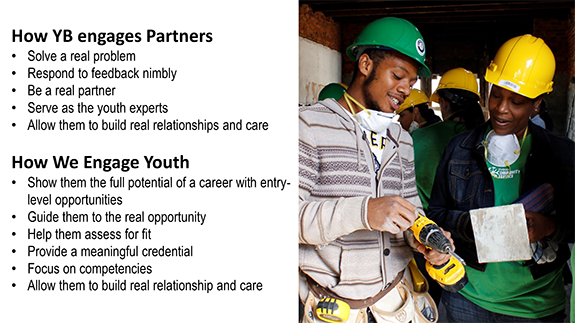Michelle Henry, vice president and senior philanthropy manager at JPMorgan Chase & Co.,2 moderated the session and said that helping job seekers, including young adults, gain the skills they need to compete in the labor market is a powerful strategy for expanding access to opportunity and promoting economic mobility. Young people in low- and moderate-income communities can thrive if they have increased access to college and career readiness and to postsecondary education, training, and high-quality work experiences, she said. Equally important, businesses can benefit from a larger and more diverse talent pipeline.
Employment opportunities for teenagers have steadily declined for more than a decade, deteriorating more than for any other population group, Henry said. The majority of people under 18 will be persons of color by 20203 and they will become our future workforce. This demographic trend encourages us to rethink how the growth and development of this population group can be supported and how employers identify and cultivate talent.
Two main themes of the session were the challenges of how to engage both employers and young people in career and technical education (CTE) initiatives.
Employer Engagement
Simran Sidhu, who until recently was executive director of YouthBuild Philadelphia (YBP) Charter School, said that YBP has increased its attention in recent years to working with employers on retention and advancement of its graduates. Each year at YBP Charter School, 220 students who have left high school prior to completion participate in a comprehensive, nurturing program that teaches academic competencies and provides on-the-job training. YBP’s program, which includes a community service component that helps increase participants’ sense of self-worth, has added a full year of follow-up support and mentoring provided by a nine-person staff.

From Simran Sidhu, “Demand Driven Pathways at YouthBuild Philadelphia Charter School,” presented at Reinventing Our Communities, September 21, 2016; available here. The photograph shows a YouthBuild Philadelphia student (left) and a Starbucks volunteer.
YBP has had a partnership with Starbucks since 2013, the year it received a youth leadership grant from the Starbucks Foundation to support its leadership development programming. After the district manager and regional director of Starbucks visited YPB and talked with its students, Starbucks began training YBP graduates for customer service positions. The relationship between YBP and Starbucks has deepened, and YBP mentors and Starbucks human resource officials have begun to share feedback about trainees, Sidhu said.
Employers have admitted they need to “listen and adapt” to work effectively with opportunity youth, Sidhu said. In the case of Starbucks, which had a goal of reducing turnover, Sidhu said that both sides have been “resilient” and stay in close communication.
In another perspective, Thomas J. Rushton IV, executive director of the Lehigh Career and Technical Institute (LCTI), said that LCTI has strong employer demand for its graduates. However, a challenge for LCTI is that it cannot keep up with the demand from some employers. For example, a local medical manufacturer recently told LCTI that, over the next five years, it will have 2,000 positions nationwide due to projected expansion and replacement of retiring workers. The manufacturer’s biggest need is for electromechanical technicians.
Founded in 1971, LCTI provides more than 45 skills-based programs of study as well as academic instruction for about 2,700 9th- to 12th-grade students from nine public school districts in the Lehigh Valley (the Allentown, PA, district is the largest). The 47-acre, 450,000-square foot complex is one of the largest CTE campuses in the U.S. and includes industry training courses for adults.
Meanwhile, Monroe County Community College (MCCC) in Michigan is working with employers on one- and two-year applied science and engineering technology programs — such as nuclear engineering, welding, construction, computer-aided drafting, and manufacturing — that are delivered in MCCC’s Career Technology Center. An example of this college–employer partnership is MCCC’s work with DTE Energy’s Fermi 2 atomic power plant. MCCC is also one of the only community colleges in the U.S. that issues National Academy for Nuclear Training certificates. In addition, MCCC is expanding its welding program in anticipation of increased demand for welders to work on a new bridge planned between the U.S. and Canada.
Student Recruitment
It can sometimes be challenging to attract young people to CTE initiatives. Rushton said that it is a continuing struggle to convince parents, guidance counselors, and young people to consider alternatives that don’t require a four-year college education. Kojo A. Quartey, president of MCCC, agreed and said that he emphasizes to students and parents the value of “credentials of economic value” that lead to good-paying jobs and careers.
Quartey said that MCCC, which currently has 3,000 students enrolled in credit programs and an equal number enrolled in noncredit programs, acts as a “hub” for high school students and students who have dropped out to come together and be exposed for one week to the college’s various programs — such as the nuclear engineering and welding programs — to drum up student interest. In one sense, Quartey is competing with employers who go to high schools to interest students in apprenticeships and internships.
Also, this fall, MCCC opened a Center for Entrepreneurial Studies that provides students with an entrepreneurial bent with counseling, mentoring, workshops, and a business incubator. The center is a partnership with the area business and economic development corporations and chamber of commerce.
Rushton mentioned that LCTI is trying to reach young people earlier through high school cooperative education programs in which students earn some money at a worksite and are mentored. He said that LCTI is exploring a junior apprenticeship model. Many LCTI students earn both high school and college credits through “articulation” agreements.4
The speakers and moderator agreed that employers play a critical role in responding to employment needs of the unemployed and underemployed and highlighted the importance of community colleges and other training providers reaching out to and understanding the needs of employers. They generally favored trying to reach young people at an earlier stage — even in middle school — to encourage early thinking about occupations and mentioned the need to involve parents in career awareness programs because of parents’ influence on the career decisions of their sons and daughters. New approaches and increased collaboration with community partners seem increasingly common in efforts to bridge the divide between education and employment for many young people.
The views expressed here do not necessarily represent the views of the Federal Reserve Bank of Philadelphia or the Federal Reserve System.
[1]Some 5.5 million 16- to-24-year-old “opportunity youth” are out of work and out of school, according to an article referenced by speaker Simran Sidhu. See Willa Seldon, Katie Smith Milway, Simon Morfit, and Brian Bills, “Hidden Talent: How Smart Companies Are Tapping Into Unemployed Youth,” Stanford Social Innovation Review, September 8, 2016; available at https://ssir.org/articles/entry/tapping_into_unemployed_youth.
[2]Earlier this year, JPMorgan Chase launched a $75 million New Skills for Youth competition to encourage states to expand and improve career-focused education that prepares students for high-skill and high-wage jobs. For information, see www.jpmorganchase.com/corporate/Corporate-Responsibility/ document/JPMC_NSFY_brochure AW4_accessible.pdf and https://ccsso.org/topics/career-readiness. In addition, JPMorgan Chase is in the midst of a five-year, $250 million global New Skills at Work initiative (see www.jpmorganchase.com/corporate/Corporate-Responsibility/new-skills-at-work.htm).
[3]See www.census.gov/newsroom/press-releases/2015/cb15-tps16.html.
[4]For resources on career and technical education and articulation agreements in different states, see https://www.careertech.org/CTE.

